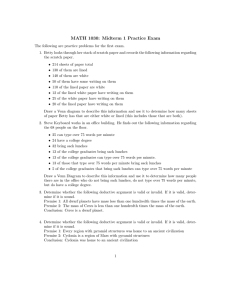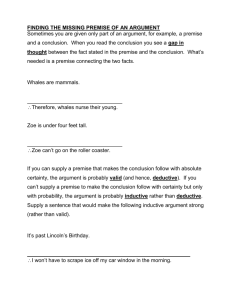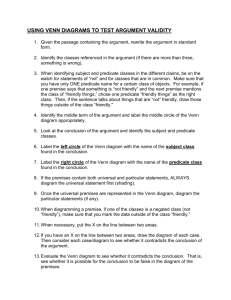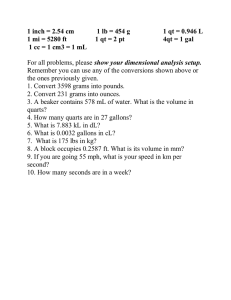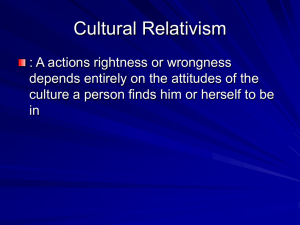MATH 1030: Midterm 1 Practice Exam
advertisement
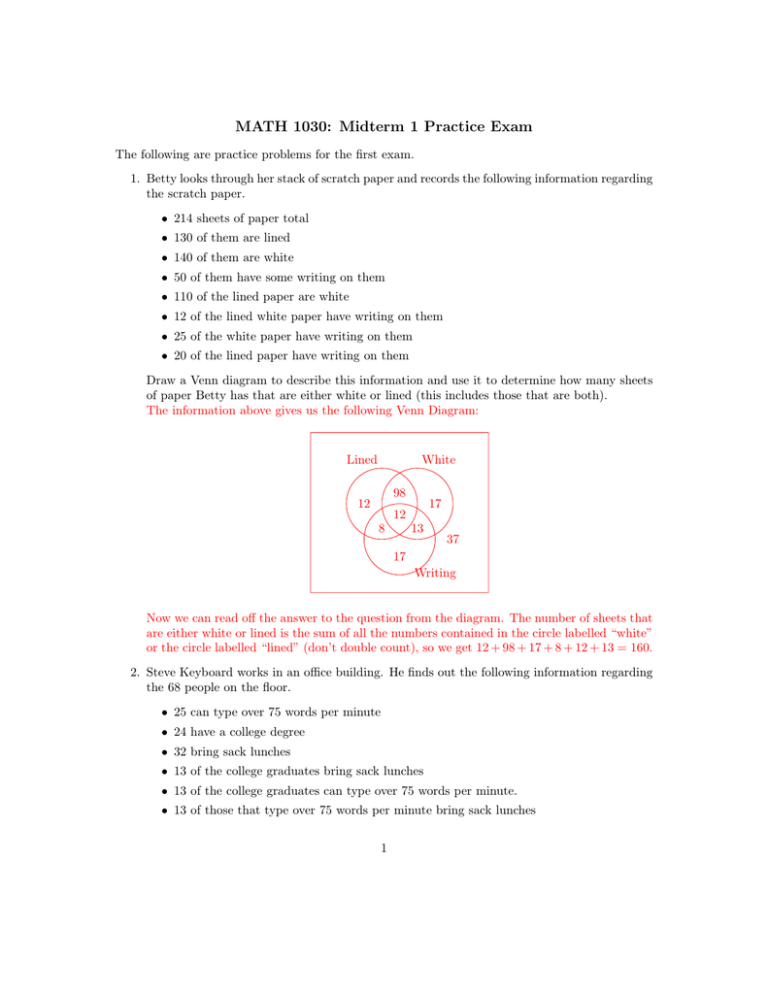
MATH 1030: Midterm 1 Practice Exam The following are practice problems for the first exam. 1. Betty looks through her stack of scratch paper and records the following information regarding the scratch paper. • 214 sheets of paper total • 130 of them are lined • 140 of them are white • 50 of them have some writing on them • 110 of the lined paper are white • 12 of the lined white paper have writing on them • 25 of the white paper have writing on them • 20 of the lined paper have writing on them Draw a Venn diagram to describe this information and use it to determine how many sheets of paper Betty has that are either white or lined (this includes those that are both). The information above gives us the following Venn Diagram: Lined White 98 12 17 12 8 13 37 17 Writing Now we can read off the answer to the question from the diagram. The number of sheets that are either white or lined is the sum of all the numbers contained in the circle labelled “white” or the circle labelled “lined” (don’t double count), so we get 12 + 98 + 17 + 8 + 12 + 13 = 160. 2. Steve Keyboard works in an office building. He finds out the following information regarding the 68 people on the floor. • 25 can type over 75 words per minute • 24 have a college degree • 32 bring sack lunches • 13 of the college graduates bring sack lunches • 13 of the college graduates can type over 75 words per minute. • 13 of those that type over 75 words per minute bring sack lunches 1 • 5 of the college graduates that bring sack lunches can type over 75 words per minute Draw a Venn Diagram to describe this information and use it to determine how many people there are in the office who do not bring sack lunches, do not type over 75 words per minute, but do have a college degree. The information above gives us the following Venn Diagram: Coll. Deg. 75 WPM 8 4 3 5 8 8 21 11 Sack Lunch Now we can read off the answer to the question from the diagram. There are 3 people who do not bring sack lunches, do not type over 75 words per minute, but do have a college degree. 3. Determine whether the following deductive argument is valid or invalid. If it is valid, determine if it is sound. Premise 1: All dwarf planets have mass less than one hundredth times the mass of the earth. Premise 2: The mass of Ceres is less than one hundredth times the mass of the earth. Conclusion: Ceres is a dwarf planet. This is an invalid argument. One way to show this would be to use a venn diagram. Recall that an argument is valid if the conclusion necessarily follows from the premises. Validity doesn’t depend on the specific planet Ceres, but rather on the structure of the argument as a whole. If the argument were valid, we could replace “Ceres” with anything, for example “Oprah.” Then the argument would read: Premise 1: All dwarf planets have mass less than one hundredth times the mass of the earth. Premise 2: The mass of Oprah is less than one hundredth times the mass of the earth. Conclusion: Oprah is a dwarf planet. Now we have (essentially) the same argument and both premises are true but the conclusion is false, so it cannot possibly be valid. 4. Determine whether the following deductive argument is valid or invalid. If it is valid, determine if it is sound. Premise 1: Every region with pyramid structures was home to an ancient civilization Premise 2: Cydonia is a region of Mars with pyramid structures Conclusion: Cydonia was home to an ancient civilization This argument is valid. We can illustrate this with a venn diagram. It is not sound because there are no pyramid structures on Mars (to my knowledge). 2 5. Suppose Maxine’s car gets 35 miles per gallon. What is her fuel efficiency in feet per fluid ounce? (128 fluid ounces = 1 gallon, 1 mile = 5280 feet) As always, the most important step is to set things up correctly. We are asked to find the fuel efficiency in some odd units so we need to start out with something that has units of fuel efficiency (like 35 mpg). Doing the conversion, we have 1 gal 5280 ft mi = 1443 ft/oz 35 mpg = 35 gal 128 oz 1 mi 6. It is estimated that when the natural dam at Red Rock Pass broke, water from Lake Bonneville flowed out at a rate of 15,000,000 cubic feet per second. Compute the flow rate of water in cubic miles per day. (1 mile = 5280 ft, 1 hour = 3600 seconds, 1 day = 24 hours) We have to convert the flow rate into cubic miles per day. So 1 mi 1 mi 1 mi 3600 s 24 hr ft3 = 8.80 mi3 /day 15, 000, 000 s 5280 ft 5280 ft 5280 ft 1 hr 1 day 7. Outer space sales tax just increased to 3.8%. If Petra’s astronaut ice creme cost $12.44 after outer space tax, how much did her ice cream cost before tax? Let’s pretend that we already knew how much the ice cream was before tax, call it P . Then if we add the 3.8% tax, or 3.8% of P to the price, we should get $12.44. So we have the equation P + .038P = $12.44 =⇒ 1.038P = $12.44 =⇒ P = $12.44 = $11.98 1.038 8. If Earth is 12.5% of the planets in the solar system and water is 71.11% of Earth, what percent of the solar system is Earth water? Earth water comprises 71.11% of the Earth, which in turn constitutes 12.5% of the solar system. To find the percentage of the solar system that is Earth water, we need to compute 71.11% of 12.5%. The keyword of means to multiply, so .7111 · .125 = 0.08888 = 8.88% of the solar system is composed of Earth water. 9. Last year Jupiter Space Suits cost $1,485. This year Jupiter Space Suits cost $1,678. By what percent did the cost of Jupiter Space Suits increase from last year to this year? We first calculate the change in price from last year to this year. Abs.Change = $1, 678 − $1, 485 = $193 Then we find what percentage of the original price that was (this is computing the relative change): $193 Rel.Change = = .1299 ≈ 13% $1, 485 3 10. The outer space economy is very unpredictable. Two years ago, outer space inflation caused the value of outer space currency to increase by 2.1%. Last year, the value of outer space currency increased by 6.3%. This year, the value of outer space currency decreased by 8.8% due to the banking collapse. Find the total percentage increase or decrease over the last two years. We aren’t told any specific amount, and we’re asked to calculate a percent change, so we can start with any amount we like, then compute the percent change for that specific amount. Let’s say we had $100 in outer space currency three years ago. Then two years ago, the VALUE of our money would have increased by 2.1%, and our $100 would be WORTH (1.021)$100 = $102.1 I want to emphasize that the actual amount of money we have is the same, but it’s value is changing. After the following year, when the value increased by 6.3%, our money would be worth (1.063)$102.1 = $108.532 Finally, because of the outer space banking collapse, the value decreased by 8.8% and is now (1 − 0.088)$108.532 = (0.912)$108.53 = $98.98 So my $100 is now worth only $98.98. Its value has decreased by $1.02, and as a percentage, it is lower by −$1.02 = .0102 = −1.02% Rel.Change = $100 11. Convert the following: • 346 Calories to Joules (1 Cal = 4184 Joules) 4184 J 346 Cal = 1, 448, 000 Joules 1 Cal • 76.5 degrees Fahrenheit to Celsius The formula to convert between Celcius and Fahrenheit is F = 1.8C + 32, so we have 76.5 = 1.8C + 32 =⇒ 44.5 = 1.8C =⇒ C= 44.5 = 24.7◦ C 1.8 • -12 degrees Celsius to Kelvin (Kelvin = Celsius + 273.15) We have K = C + 273.15 = −12 + 273.15 = 261.15. 12. If a person with 5 Liters of blood consumed 4 grams of alcohol, what is this individual’s blood grams alcohol content in ? 100mL The blood alcohol concentration is the amount of alcohol in the blood divided by the total amount of blood, so we have 4 grams 1L BAC = = 0.0008 g/mL = 0.08 g/100mL 5L 1000 mL 4 To understand the last equality in this equation, consider this: If there are 0.0008 grams of alcohol in 1 mL of blood, how many grams are there in 100 mL of blood? There should be 100 × 0.0008 = 0.08 grams of alcohol. 13. Use scientific notation to do the following computations: • (87, 100, 000, 000, 000, 000, 000)(.00000000000000011) If we convert these numbers to scientific notation, we have 8.71 × 1019 1.1 × 10−16 = 8.71 · 1.1 × 1019−16 = 9.581 × 103 = 9, 581 • .00000000000012 30, 000, 000, 000, 000, 000 We convert to scientific notation which yeilds 1.2 × 10−13 1.2 = × 10−13−16 = 0.4 × 10−29 3 × 1016 3 5
